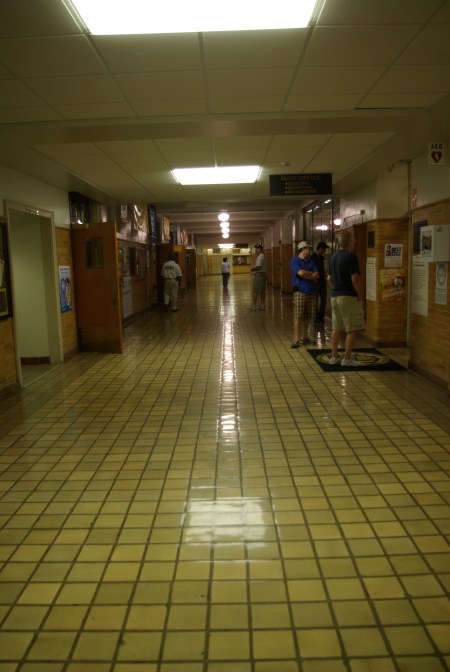On the way out of Little Rock, Arkansas, after our day at the William Jefferson Clinton Presidential Library and Museum, we stopped at the Little Rock Central High School National Historic Site.
In 1957 nine African American kids tried to enroll at the school, breaking high school segregation in Little Rock. After assuring President Dwight Eisenhower that the Arkansas National Guard would preserve the peace, Gov. Orval Faubus ordered the Guard to keep the students out. Eisenhower called up the Guard to federal duty, and sent in the 101st Airborne from the regular U.S. Army to enforce the desegregation rules. (Imagine any president doing that today!)
Eventually Little Rock closed down all the schools for more than a year, and then federal courts ordered the schools opened, but desegregated. One black student graduated that first year, Ernest Green. The other eight all graduated, but from other schools around the world.
Today, it’s history, even in Little Rock.
Little Rock Central High remains in use today. The National Park Service maintains a visitor center across the intersection from the school, with the old Magnolia Oil gas station, restored, on another corner, and a monument to the Little Rock Nine and civil rights on the remaining corner (Magnolia Oil was absorbed into Mobil, which took on Magnolia’s flying horse emblem). Our Dallas Independent School District, Teaching American History Grant group visited in mid-June. Classes were out. The visitor center remains open year around.
I was particularly curious to see whether and how the historical events, and the commemoration of them, affect the school itself.
On the inside, it’s a normal American high school — though in a grand building (I’d compare this to Ogden, Utah’s Ogden High School, a WPA-style project of a decade later’s construction, and a grand old building students and citizens have come to love).
Walls bear posters from student clubs. Signs direct students to classes, or the auditorium, or the lunchroom. The office looks more like the 1970s than the 1930s — I suspect it has been updated. Ceilings have been redone since 1927, with newer fluorescent lighting and acoustic ceiling tiles, which only brings the architecture of 1927 down to 1970s box-style building standards.

Walls of Little Rock Central carry notices of club meetings, much as in 1957. Some of the clubs have changed; the Gay-Straight Alliance probably was not active in LIttle Rock in 1957. Changes in U.S. culture in the 54 years since the Little Rock Nine, are reflected in the citizens and their actions, and not necessarily in the physical buildings.
It’s a working school, and not a monument on a pedestal frozen in time in any sense.
The school opened 30 years before it became an icon in the struggle for civil rights. It is a massive structure, intended perhaps as a sort of monument to Little Rock and to Education. NPS describes it at their website:
Built in 1927 as Little Rock Senior High School, Central was named “America’s Most Beautiful High School” by the American Institute of Architects.
Designed as a mix of Art Deco and Collegiate Gothic architectural styles, the building is two city blocks long and includes 150,000 square feet of floor space. More than 36 million pounds of concrete and 370 tons of steel went into the building’s construction. It cost $1.5 million to construct in 1927. The school received extensive publicity upon its opening. An article in the Arkansas Gazette said, “we have hundreds of journalists in our fair city for the dedication” of the new high school.
At its construction, Central’s auditorium seated 2,000 people and included a 60 x 160 ft. stage that doubled as the gymnasium. A new library was built in 1969 and named for longtime principal Jess W. Matthews. In 1953 the school’s name was changed to Little Rock Central High School, in anticipation of construction of a new high school for white students, Hall High School in Pulaski Heights.

Computer classroom at Little Rock Central High - Historic preservation cannot prevent the updating of classroom technology. Wiring these classroomms for computer networks must be quite difficult.
I thought it interesting that the original construction did not include a library. The auditorium’s doubling as a basketball gymnasium explains the massive stage — suitable for Las Vegas, really. “Multi-purpose” building for schools originated much earlier than the 1970s as I had imagined. The 1927 plans included neither the tendency to overbuild fschools for athletics, nor today’s pre-occupation with making schools appear as academic enclaves.
Visiting the site you can learn that the $1.5 million cost consumed the entire building budget for the district in 1927. In keeping with the separate but equal doctrine of the times (see Plessy v. Ferguson), the Little Rock district “planned” to build a high school for blacks at the same time. No money remained for either design or construction.
City leaders — I would imagine black city leaders, without much help from whites, but I may be too cynical — raised money to pay the same architects to create a complementary design for the school that would be called Dunbar. Private funding paid for construction, too. Exactly this sort of discrimination against blacks roiled across America from 1896 into the 1950s — only 16 states banned discrimination by race, with laws that were not always enforced. These issues were key to several of the cases rolled into the Supreme Court appeal that we usually call simply The Brown Decision — facilities were involved in the cases in Topeka, Kansas, Prince Edward County, Virginia, Delaware, and Washington, D.C.
Looking at Little Rock Central High School today one can see the physical manifestation of the insidious separate but equal doctrine, and understand perhaps why it collided with the drive for rights in Little Rock, at the corner of 14th Street and South Park Street. The school’s address is listed as 1500 South Park. 14th Street, running along the north edge of campus, has been renamed Daisy L. Gatson Bates Drive, in honor of the NAACP organizer who provided wise counsel, sage advice, a ride to school on most mornings and friendship to the students who made up the Little Rock Nine.
A large amount of history resides in Little Rock.
Ha! — You don’t need to rely on my photos at all. Turns out NPS has a photo slide show at their website. Note how my ideas paralleled theirs — and honest, I didn’t see that before our tour. Actually, the auditorium curtains were closed, nor did we get into the balcony — the photo from NPS is much better than any I got.
Nota bene: The intense, three-year program of study of U.S. history for this three dozen or so teachers is made possible by a grant from the U.S. Department of Education, a Teaching American History Grant. Such grants fund the study of American history for teachers across the nation, to spur better teaching from greater understanding and knowledge of history. These grants generally float at the top of the pool of programs to be cut first when the budget axes fall. We are grateful to the Department of Education. And while my writings here do not necessarily reflect the views of any of my employers, past or present, they should — and the Senate, Department of Education and others in the stream of funding would be well-advised to continue these grants.










[…] Little Rock’s Central High School, monument to civil rights (timpanogos.wordpress.com) (Millard Fillmore’s Bathtub) Little Rock Central High School, National Historical Site Visitors Center – (Photo credit: bigskyred) Share this:TwitterStumbleUponDiggRedditFacebookEmailLinkedInPinterestTumblrLike this:LikeBe the first to like this. […]
LikeLike